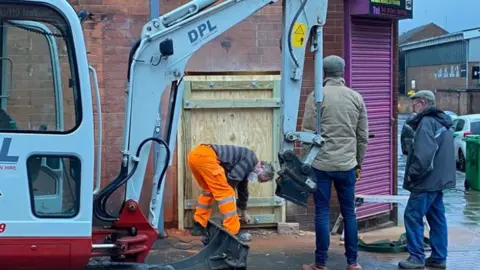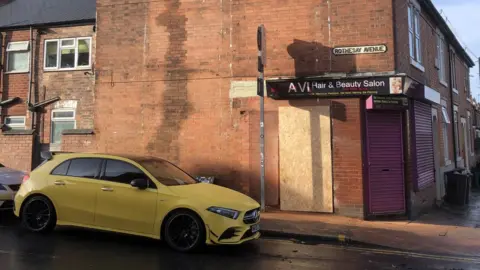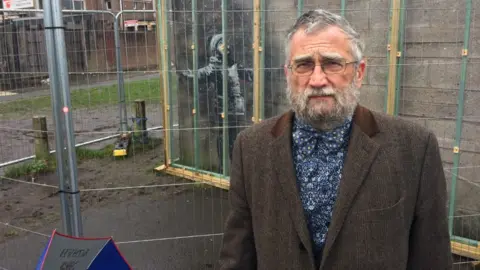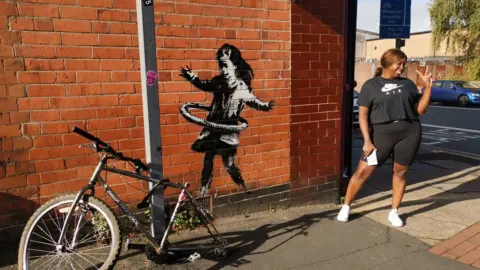Banksy: Hula-hooping girl removed and sold for 'six figures'
 Dan Golstein
Dan GolsteinA Banksy artwork has been removed from the side of a building in Nottingham and sold to a collector.
The mural, which depicts a girl hula-hooping with a bicycle tyre, appeared on a residential street in October.
The "slab of brick" was seen being cut from the wall in Rothesay Avenue from about 05:00 GMT.
Gallery owner John Brandler told the BBC he paid a "six-figure sum" for the piece, and wanted to help preserve it, as well as put it on display.
Resident Dan Golstein said workmen were "drilling into the wall" in the early hours. The artwork was then seen being loaded into the back of a van.
Mr Brandler said the workers were part of a "very specialised company" which had removed Banksy art before.
He added he is now sending it to Scotland to be restored.
The collector owns a number of the elusive artist's pieces, including Seasons Greetings, which he bought from a garage in Port Talbot in 2019.

He claimed he had saved the Nottingham artwork "in time" before damp could cause damage under the plastic cover put on by Nottingham City Council.
"If you put Perspex over a picture the moisture gets into the brick wall and can't escape - the wall needs to breathe," he said.
"If I hadn't bought it and removed it, in two years' time there wouldn't have been a Banksy there at all."
Mr Brandler said he planned to feature the piece in a street exhibition later this year at the Moyse's Hall Museum in Bury St Edmunds, Suffolk.
But he added: "Work with me and it would be lovely to bring the whole show back [to Nottingham]."
City rejuvenation board The Nottingham Project said they had been in touch with Banksy's team - Pest Control - since the mural appeared, and they believed its removal would go against his wishes.

A spokesman said they had sought Banksy's approval to move the piece to a different location in the city.
He said: "They responded asking for the artwork to remain, so we respected the artist's wishes."
"Whilst we respect that this was a private decision for the landlord, we think it's a great shame that Nottingham has lost its Banksy and we hope this doesn't stop the artist coming back to the city in the future," he added.

Analysis: Will Gompertz, BBC News arts editor
In art world terms, this would be described as a site specific work, meaning Banksy specifically chose that location for that work and that's what made it successful.
Don't forget Nottingham's relationship with bicycles and bicycle making, with Raleigh the most famous of many firms. And Banksy would have been aware of all this.
It was intended to be there, enjoyed by people, to be a social comment - it wasn't Banksy's intention that it be chipped off the wall and taken somewhere else.
He does accept it's part of what happens to his work - others have been whitewashed and had graffiti put all over them so they're no longer visible.
But my own view is the work is substantially diminished by removing it because the work was so site specific, because it was responding to the bike on the lamp-post, because it was responding to the history of Nottingham, it worked so well in that spot.
When you remove it, it is diminished, it doesn't say the same things, and I think it is worth less. Not worthless, but worth less.

A Nottingham City Council spokesman said the authority had tried to secure the work for the city but "those options were exhausted" and so it was left to the property owner to decide what to do next.
But he said the council had been unaware of the plans to move it.
'No idea'
Surinder Kaur, who leases the building, said: "I didn't know anything about this - no-one has informed me. I'm shocked now at what's going on."
The Nottingham Post reported the owner, who wanted to remain anonymous, had tried to "donate" the artwork and said "substantial discussions" had taken place with a number of local organisations, charities and national bodies, which ended unsuccessfully.
According to the newspaper, they said: "Since we were unable to donate the artwork itself, we'll be donating the proceeds privately instead."

The BBC has attempted to make contact with the building's owner.
The hula-hooping girl first appeared on the building, at the junction of Rothesay Avenue and Ilkeston Road, on 13 October.
A few days later it was claimed by the artist via his Instagram account, and people flocked to have their picture taken next to it.

Many local residents have expressed their disappointment at the mural's removal.
Jasinya Powell, 39, said: "It's capitalism at its finest - it's all about the Benjamins [money] at the end of the day.
"At least we got a taste of it.
"It got people talking about Raleigh, about Nottingham, about what the city has produced and done."

Alex Mitchell-Messam, 32, saw the artwork being put up covertly just a few yards away from his shop.
He said people were still visiting to take photos of it until yesterday.
"It's sad to see it's leaving," he said. "I think it should stay in the area it was put in.
"Banksy travelled to Nottingham, he chose to put that artwork here when he could have chosen anywhere.
"It was great, bringing new faces to the area and having a vibrant effect."


Follow BBC East Midlands on Facebook, on Twitter, or on Instagram. Send your story ideas to [email protected].
